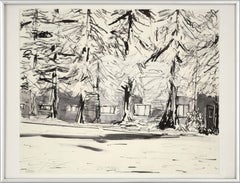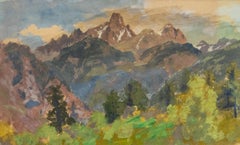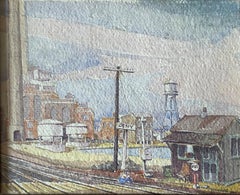Michael Pauker Landscape Drawings and Watercolors
Inspired by Abstract Expressionism and driven by deep curiosity, artist Michael Pauker has created an expansive oeuvre that is inclusive of abstract and figurative paintings, landscapes, sculptures, prints and collages constructed with scraps of aging historical documents, watercolor paints and found objects.
“As an artist, I am not a one-trick pony,” he has said. “Some artists find success doing one thing and stick just with it. But my curiosity is omnivorous. I’m driven by images I’ve never seen before, both abstract and figurative.”
Born in 1957 in New York, Pauker knew he wanted to be an artist from the age of 15. He earned his BFA from the State University of New York (SUNY), then in 1989, completed his MFA at Mills College (now Mills College at Northeastern University) in Oakland where he was awarded the City of Oakland Fellowship in Painting.
Since 1988, Pauker has lived and worked in the Bay Area, teaching art in various venues such as schools, colleges and institutions including the California Medical Facility in Vacaville, the state’s prison hospital, for several years. When he isn’t teaching, Pauker focuses on creating art — the mediums of which can change by the moment.
While he works in oil on canvas for most of his paintings, Pauker is also known for his “Miniature Collage” series. He has worked on this series for more than a decade. Other works include abstract drawings and figurative watercolors blended with collages of vintage paper, stamps and found objects — his Oesterreich II is an example of the latter.
Pauker has exhibited widely across the United States, Japan and Costa Rica, and his works are held in the public collections of many institutions including the Fine Arts Museums of San Francisco.
Find authentic Michael Pauker art on 1stDibs.
2010s American Impressionist Michael Pauker Landscape Drawings and Watercolors
Paper, India Ink, Watercolor
1910s American Impressionist Michael Pauker Landscape Drawings and Watercolors
Gouache
1910s American Impressionist Michael Pauker Landscape Drawings and Watercolors
Paper, Watercolor
1960s American Impressionist Michael Pauker Landscape Drawings and Watercolors
Ink, Watercolor
1920s American Impressionist Michael Pauker Landscape Drawings and Watercolors
Watercolor
Early 20th Century American Impressionist Michael Pauker Landscape Drawings and Watercolors
Paper, Watercolor
21st Century and Contemporary American Impressionist Michael Pauker Landscape Drawings and Watercolors
Paper, Gouache
Mid-20th Century American Impressionist Michael Pauker Landscape Drawings and Watercolors
Paper, Watercolor
Early 1900s American Impressionist Michael Pauker Landscape Drawings and Watercolors
Crayon, Watercolor, Board
Early 20th Century American Impressionist Michael Pauker Landscape Drawings and Watercolors
Paper, Watercolor
1950s American Impressionist Michael Pauker Landscape Drawings and Watercolors
Watercolor, Paper
Mid-20th Century American Impressionist Michael Pauker Landscape Drawings and Watercolors
Watercolor
Mid-20th Century American Impressionist Michael Pauker Landscape Drawings and Watercolors
Watercolor


